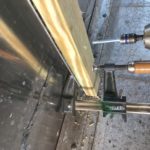The edge of perfection is a balancing act. The biggest and most comfortable mobile road dwelling would probably be a double decker bus. You’d have enough room for a hot tub, flush toilets, guest rooms, the works….but busses get 4 mpg and are more difficult to maneuver than a van. Then you’d have all the complications and hassle of maintaining the bus, hot tub, and pumping out your holding tanks. The bigger and more heavy duty the vehicle is the more expensive the parts are to fix it. The more complicated and time consuming things are to maintain, the less fun it is. The more expensive it is to run the more it becomes like a job rather than a stepping stone to freedom.
“There are two ways of becoming wealthy. One way is to make more money, the other is to want less, but the best way is to do both at the same time.”
One thing that I learned while long distance back packing is that less is more. (read about my A.T. thru-hike here). The less I carried on my back, the more comfortable my hiking experience was. Conversely however, carrying more items increased my comfort in camp. These two opposing forces pushed me to the cutting edge as far as gear selection. There was no room for “maybe I’ll use this at some point kind of thinking”. If a piece of gear wasn’t absolutely essential, I got rid of it. If I found something that worked better than what I had and it was lighter, I replaced it. Items had to have a lot of value for me to carry their gravitational burden on my back. The tiniest thing was scrutinized. By keeping my pack light I could comfortably hike more miles per day and I didn’t need to carry as much food to get me to the next resupply point. In that way, carrying less gave me a compounding sense of freedom.
This philosophy of traveling light can be applied to van dwelling and finances as well. A smaller vehicle will generally get more miles per gallon therefore costing you less and allowing you to stretch your travel budget further. With smaller overhead you can stay out longer between jobs and save more.
But you still want a big enough van to be able to create a cool and enjoyable mobile lifestyle. The goal is to make this comfortable enough to want to do it for a meaningful amount of time. In the example I gave in my post “Why live in a van?” we talked about buying a nice used van with a bank loan and using what would have been paid to the landlord in rent to pay back the bank. In this way I explained that if you lived in your van for one year it would be like getting the van for free. EXAMPLE: If you have been paying $800 a month in rent, you could buy an $9,600 used van and pay it off in one year. You now own a mobile one bedroom apartment!….Ok, on to selecting a vehicle!
First, I would suggest a stealthy windowless cargo van as the best option. The problem with RV’s and camper vans is that people can see light shining through the windows at night. That’s ok if you only plan on traveling in the country, but if you want to stealth camp in urban areas you need something more discrete. Camper vans look like the kind of van a hippie may be living in and people don’t always accept alternative lifestyles. In order to have the freedom to park anywhere you want, without people getting suspicious, you need something that fades into the background. In a windowless cargo van nobody can see the light of your computer screen while you are parked in front of their house and stealing their wifi. A cargo van doesn’t look like a live-aboard. People would be surprised if they knew you were in there watching Netflix in your pajamas!
Step Vans
My favorite and probably the roomiest option are step vans, such as “Fed Ex” type vans. I lived in one of these in the San Francisco Bay Area years ago and it was awesome! Just imagine how much rent free living space a vehicle this size offers you. In most cases you don’t have to own the ground underneath the tires to be able to park there. I guess even with van dwelling you still have to pay a registration and insurance fees but that pales in comparison to renting an apartment. Step vans have nice straight walls which makes installing cabinets and paneling the interior easy. I prefer the “high top” vans with hinged rear doors rather than roll-up doors (roll-ups infringe on your living space). Another upside to step vans is that the bodies are made of aluminum and do not rust! A truly luxurious and long lasting van home can be built in a step van. The downside is that they often get about 10 mpg although diesel versions do better. There are many of these available on the used market and because they are aluminum even the older ones look pretty good!
Diesel powered vans get better gas mileage but purchase price and maintenance is often higher than with regular gas powered vans.
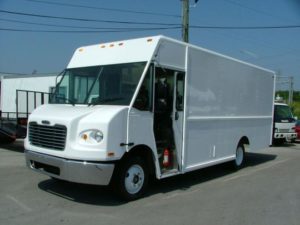
Older full size cargo vans
There are lots of full size and full size extended cargo vans out there on the used market that will work too but the interior walls are curved which makes building the interior more difficult. Most don’t have standing headroom either. Pictured below is what I have at the moment, it is a 2005 Ford Econoline E-250 extended cargo van with a 4.6 liter V8. I get about 13 mpg combined city/hwy with this van. You can find some of these with fiberglass high top roof extensions so that you can stand up tall on the inside. You can also buy high top roof extensions aftermarket but they are pricey. I have also seen creative people add pop tops to these.
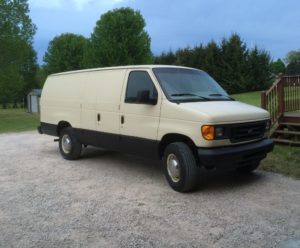
Sprinters
I was going to group the newer style of cargo vans all together with “Sprinter” vans as they seem to have all since adopted this body style and offer diesel options like the Sprinter. But, the Sprinter was the van that set the bar for this new generation of vans. These vans have a lot going for them. Some are offered with very efficient diesel engines and can get 25 mpg! You see a lot more of these produced with the high roof option. I guess the thing that I don’t like about them is that you don’t get a full 8′ width like you do with a step van. The width is more comparable to other full size vans. Sprinters have been around for awhile now and there are many on the used market, they seem a little pricey though and are often rusty. I think they may have used cheap thin coatings of paint on these vans that just doesn’t hold up. Many used ones I’ve seen out there sell for $10,000+ but are rusty and already have 200,000 miles on them. “Sprinters” can be found with either a Mercedes, Dodge, or Freightliner logo on the grill.
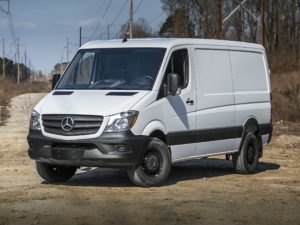
New School cargo vans
The Sprinter has brought about a shift in the other manufacturers toward more fuel efficient cargo vans with similar angular front ends and diesel powerplants. Some of these newer vans are the Ford Transit, Dodge Promaster, and Nissan NV.
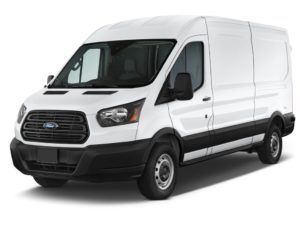
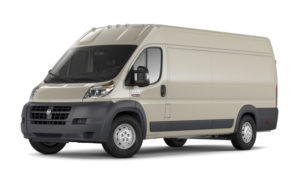
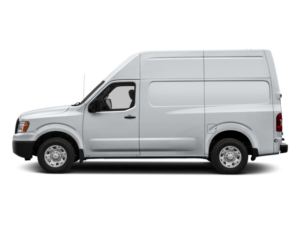
I’m not going to say much about these vans because they are so new that the purchase price on used ones is still quite high. The objective we are seeking here is to be thrifty. We want a good dependable vehicle but we don’t need to spend $30,000 or more to get that. The goal is to be able to pay it off with what we would have spent in rent in one year.
Other Vans
There are other options out there such as mini vans which get great gas mileage but are kinda small. The shear number of family vans out there on the used market means you can find them pretty cheap, but many have windows. Some people make blackout curtains to cover up windows, but I prefer starting out with a cargo van. You may certainly find something not listed here that could work well for you. My top pick however would be a diesel powered Step Van : D



